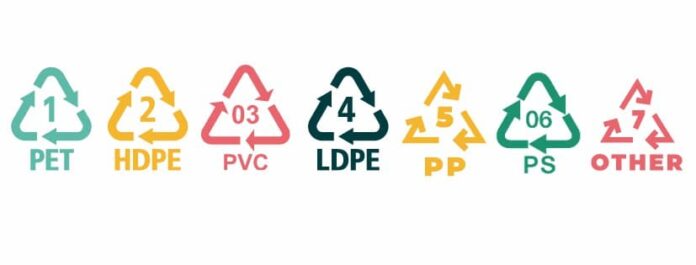If you take a look at the bottom of your plastic bottles, you will see some of them have different numbers. The numbers and symbols on plastic items tell you about their conditions and types. You will find all the important information about the recycling numbers on the plastic below, so check them out.
1PET / PETE (Polyethylene Terephthalate)
Polyethylene terephthalate is the most common plastic for single-use bottled beverages and other items. It is easy to recycle, lightweight, and inexpensive while posing a low risk of leaching breakdown products. This type of plastic is often clear in color, it is not ideal for multiple uses. Because you can only use it one time, PETE is not the plastic that you want to recycle as a drinking bottle at home. The items with PETE plastic are usually bottles, cooking oil containers, and other plastic containers for food items and kitchens. After use, PETE is recycled into carpet, fiber, furniture, polar fleece, tote bags, and many more.
2HDPE (High-Density Polyethylene)
Being tough and versatile, HDPE is extremely common for many everyday items in the house especially packaging. Unlike PETE, HDPE carries a low risk of leaching which makes it one of the safest types of plastic. At the same time, it can also withstand freezing and heating so you can use it in various weather conditions. Plus with its high density, this type of plastic is super wear-resistant to have for long-term use. Because it is durable, reusable, and sturdy, HDPE is ideal for chairs, cleaning products, milk jugs, shampoo bottles, toys, etc.
3PVC (Polyvinyl Chloride)
PVC is flexible and soft plastic, and it is common in a wide range of household products. The thing that you have to know about this type is that it contains chlorine and other toxic chemicals. Apart from being dangerous, this plastic is also one of the least recyclable types as well. Remember not to burn PVC products because it releases a toxin that can be harmful to your health. Should you need to get rid of PVC items, make sure to throw them away properly. Another thing to have in mind is to avoid buying baby toys, inflatable items, or kid products that contain PVC. It is great as long term objects like piping, plastic tubing, or wire jacketing but not for everyday items,
4LDPE (Low-Density Polyethylene)
As for this type, it is very common in bread wrappings, grocery bags, newspaper bags, packaging foams, trays, etc. LDPE is flexible and food-safe, and you can use it a few times before throwing it away. This plastic has good resistance to acids, alcohols, and dilute alkalis along with great temperature resistance and high impact strength. Besides being common in packaging industries, LDPE is also ideal for electrical insulating properties as well. This plastic is recycled into compost bins, floor tile, landscaping ties, lumber, shipping envelopes, trash can liners, and more.
5PP (Polypropylene)
With its high melting point, PP plastic is common and ideal for containers that hold hot liquid. Today, it is also common in items such as cereal box liners, kitchenware, plastic bottle tops, yogurt containers, and more. Polypropylene plastic is also used in disposable objects such as cups, cutlery, diapers, plates, etc. On top of that, plastic number 5 is also microwave safe as it remains cool while the contents inside are warm. Not to mention that it is very sturdy, you can also reuse it multiple times as well. There are large PP containers that you can recycle as storage boxes for smaller items, and they last for years.
6PS (Polystyrene)
Polystyrene is a type of plastic that can be made into foam or rigid products; hence the trademark Styrofoam. Plastic number 6 is common in coolers, disposable coffee cups, egg cartons, snack packaging, to-go food containers, and many more. This is the type of plastic that you should avoid using or at least recycle as much as possible. PS is the plastic that is often found on beaches and in marine animals. Although it is cheap and lightweight, it is quite fragile and notoriously difficult to recycle. It also contains carcinogens (radioactive substances) and styrene which can leach into food and can be harmful to health.
7Miscellaneous
For plastic that does not fit into the six above, it belongs to the last category which is miscellaneous. Products with the number 7 are usually a combination of multiple plastic types or other types of difficult-to-recycle plastic together. Those include bioplastic and new plastic, and this number also stands for polycarbonate (PC) which contains highly dangerous BPA. Plastic with label number 7 or PC is the type that you should try to avoid especially kids’ items. The most common items of this plastic are car parts, computer cases, lids, three and five-gallon water bottles, etc.
Related Post: Things You Should Know About The Ocean




